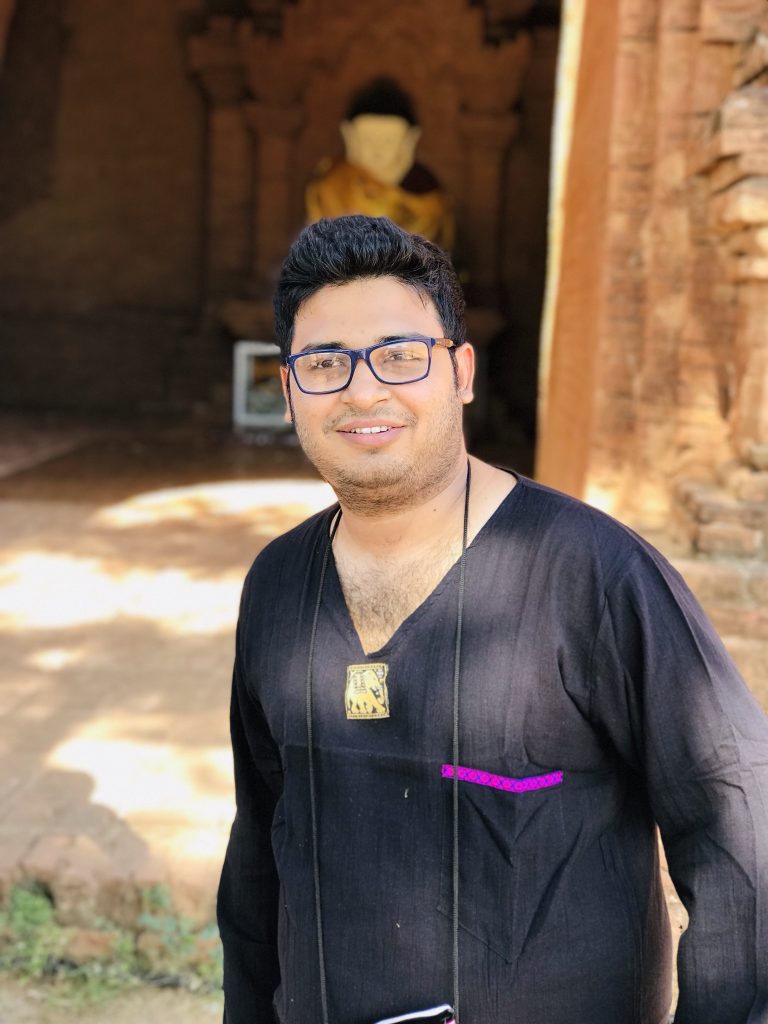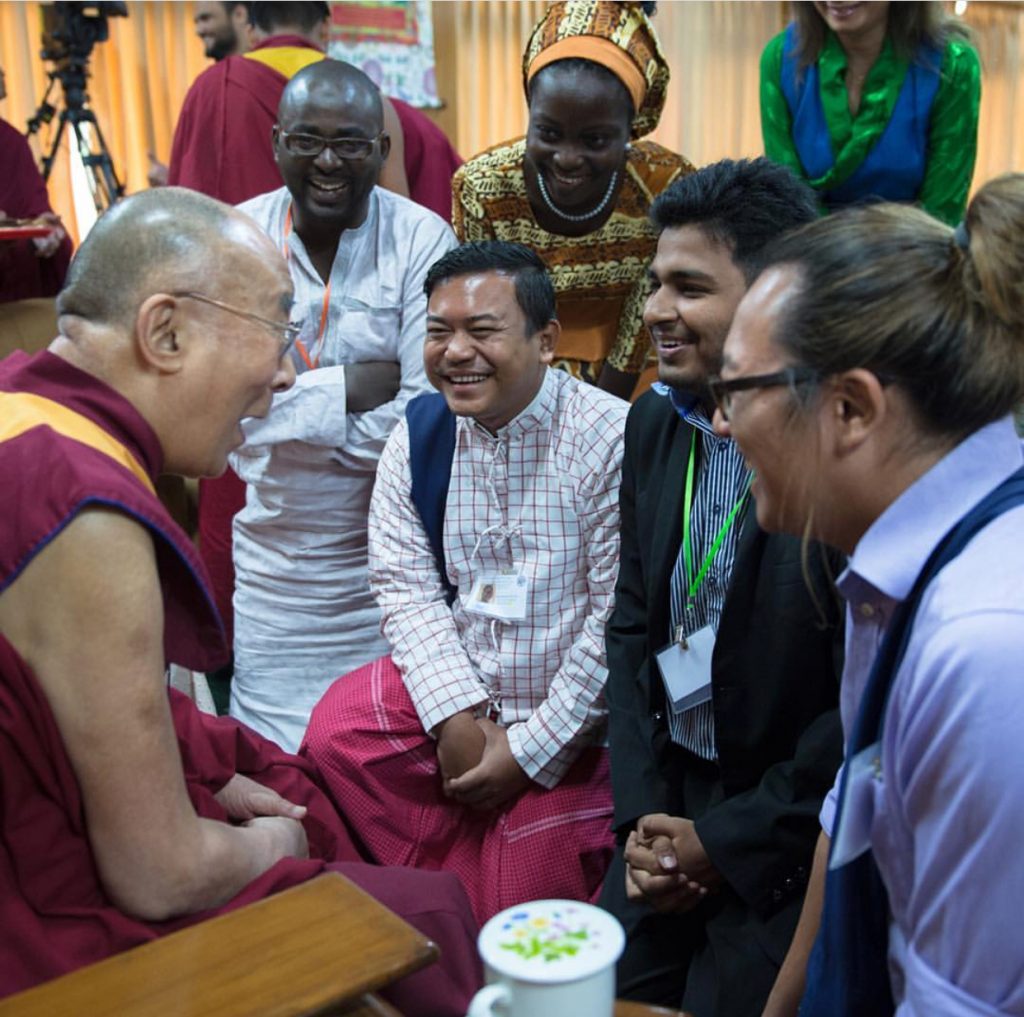Peacemaking in Myanmar: iPACE and CONTACT alum Harry Myo Lin
February 15th, 2019 | SIT

Harry Myo Lin has a vision for a peaceful Myanmar. He has been working toward that vision ever since conflict broke out in the Rakhine State in 2012—promoting interfaith dialogue first through the Mandalay-based NGO he founded called Seagull, and now at the international peacebuilding organization KAICIID. Last month, TIME magazine recognized Harry for his efforts in a feature on eight young leaders shaping the decade ahead. “It is an honor,” Harry says.
Harry is one of the many members of the World Learning/School for International Training (SIT) alumni community. In 2013, he joined World Learning’s Institute for Political and Civic Engagement (iPACE) in Mandalay as a trainer, leading courses from conflict transformation to transitional justice and peace advocacy. Then, in 2014, he traveled to our headquarters in Brattleboro, Vermont, to participate in CONTACT, a three-week program that brings together participants from around the world to explore the theories and practices of peacebuilding.
We recently chatted with Harry to learn more about his work and how his participation in iPACE and CONTACT have helped him push that work forward.
When did you realize you wanted to become a peacebuilder?
I have some monk friends. When the conflict in Rakhine began in 2012, we met and predicted that the conflict could also happen on the mainland, in Mandalay and other regions, because there were a lot of rumors and propaganda going around calling for violence. We wanted to stop this, so we started to work on creating open dialogues.
What kind of rumors?
At that time, there were rumors that Muslims were attacking Buddhists. The rumors were not true but made people fearful. And, also, in some Muslim communities there were rumors that Buddhists were coming to attack them—they were prepared and waiting to fight back. So, these kinds of rumors created tension and pressure between the different communities.
What were some of the tactics that you used to stop the rumors? I know you started a Facebook group.
At the time, there was a lot of fear in the community. It was just the beginning of the transition in Myanmar, so people were afraid to go out or talk outside. Facebook started to become popular. It became a way to communicate with each other—when rumors happened, we could easily get in touch and share the real information.
The Facebook group was more for communication between likeminded people from different towns. The actual work was outside of Facebook. As soon as we heard rumors or wrong information, we tried to communicate with the local people to make sure these rumors didn’t spread so much that could lead to violence.

Would you go straight to the community members?
I worked with different people, especially the religious leaders and the monks. We worked together, we reached out to communities. They have more influence, but we tried to support them with information as they talked to their community. And we also organized training on conflict transformation and interreligious dialogues so that the religious leaders could get to know each other and make communication channels.
How did you use your experience promoting interreligious dialogue at your NGO, Seagull, when you began to teach at iPACE? And how did teaching help you reflect on your work?
I tried to use some of the examples [of work I was] doing outside of iPACE. Like in peace advocacy classes, I shared some of the case studies of what I was doing for peacebuilding in Myanmar. Then I got feedback from the participants that was useful in my work.
Did they have some good ideas for you?
Yes, one of the very practical ideas I got from iPACE is, when we were doing a dialogue about how to build up the capacity of negotiators, one of the participants suggested that we should have longer term sustainable institutions to teach these skills in Myanmar. It helped me to design one of the projects I’m working on now: building an institution on interreligious dialogue.
Would you mind telling me more about that project?
I’m working for KAICIID, an international dialogue center, and as part of one of the projects I’m working on, we are building an interreligious dialogue training center where we train young people and religious leaders more intensively about conflict transformation and interreligious dialogue. It is a two-week program. It’s kind of a mini CONTACT.
Yes, you participated in CONTACT in 2014. Why did you join that program?
Before CONTACT, most of the skills and knowledge I had were through self-study. We didn’t have much training and academic teaching about conflict in Myanmar. When I looked at the CONTACT program, it was very interesting. In a short time, they teach a lot about academic learning for peacebuilding—they teach a lot of theories, and also experiential learning and cross-culture learning. So, it was very interesting for me.
How did those skills and the more theoretical academic grounding from CONTACT help you with your work going forward?
CONTACT made me think more about sustainable approaches to peacebuilding and encouraging dialogue. I co-founded an organization together with a CONTACT alumnus to reach out to different faith communities and set up a sustainable conflict transformation process in different areas. I also started to do more policy-oriented work, reaching out to decisionmakers and policymakers so they could take proper steps to overcome structural problems and build a sustainable peace.
Are you still in touch with professors and other CONTACT alumni? How useful has the CONTACT network been for you?
Yes. In 2016, we organized a peacebuilding Training of Trainers (ToT) in Yangon. iPACE brought in Paula Green, the founder of CONTACT, and we offered a more advanced ToT to participants from Yangon. I partnered with the Karuna Center for Peacebuilding, an organization Paula founded. And I have been in touch with CONTACT Professor Tatsushi Arai. I consult a lot with him because he’s also an expert on Myanmar. We’ve become very close and I ask him questions, even about my career. [When I began working for] KAICIID, we invited Professor Arai to Thailand for a Buddhist-Muslim dialogue.
I also have contacts with some of the alumni, especially in India. We talk very often. We share what’s happening to us and what’s happening to our communities. We share information. And sometimes we try to do joint advocacy efforts.
In 2017, you left Seagull to join KAICIID. What appealed to you about working there?
KAICIID, for me, was going to the next level. At Seagull, I was focused on Mandalay and the area around Mandalay in a very grassroots way, which is good. I believe the initiative had already grown enough to sustain itself and I wanted to try a wider area. With KAICIID, we can do national work. We’re trying to set up an interreligious platform that can be functional in all parts of Myanmar. So, it’s the next level for me.
Also, one of the core mandates of KAICIID is to promote dialogue between religious leaders and policymakers, which is [another one of] my interests. We need to bring together policymakers also in the interreligious dialogue so that we can have sustainable dialogue platforms and address systemic and structural problems.
What are the concrete next steps to building that interreligious platform?
We’re trying to build a network with policymakers to bring policy change which can address some of the root causes of the interreligious tension in Myanmar. We’re also working on educational reform to include more inclusive education system.
Are you working with school officials? What are you doing exactly to build a more inclusive education?
I am leading a project to do research on the formal education curriculum. We are finding ways to address how to make sure the formal education system doesn’t teach incorrect perceptions. Also, I am working with some of the university teachers to do an intervention that can reach out to future teachers to [provide them with] knowledge about religious and cultural diversity.
So why should people consider training at iPACE?
iPACE, I think it is still the only institution in Myanmar that within four to five weeks can build up certain skills that are needed for people who are working on civic engagement and peacebuilding and other areas. It’s a very effective program, especially for newcomers and also for people who are already working in the field.
Another thing is, iPACE has a huge network in Myanmar. It brings together people from different parts of Myanmar and different organizations, which can help us build a good network.
How about CONTACT? Why should people study with CONTACT?
CONTACT is a really different, life-changing experience. It has created a lot of opportunity and also links our experience and skill with theoretical approaches. [I also appreciate the] regional aspect. It’s not only Southeast Asia, it’s also South Asia and Southeast Asia, so it really brings a good diversity of people.
So you can share best practices across the region?
Yeah, and also learn about cultures and differences. Because in most of the countries, a certain group is a majority, and in another country, it becomes a minority. So, it’s really about teaching sympathy to people in the same field from different countries.
What’s your vision going forward for Myanmar?
Myanmar is a diverse country and we have been through a long history of conflict and violence. We really need to find a way to have dialogues with each other and overcome this violent conflict. Only then can we go to a better, more peaceful, and developed Myanmar. So, we need a lot more effort from different stakeholders to work on dialogue instead of fighting.
Also, because we have had such a long period of violent conflict, we really need to focus on healing these traumas in every community in Myanmar so that we can overcome the cycle of violence.
Want to read more? Check out the TIME magazine feature, “Eight Young Leaders on How They Want to Shape the Decade Ahead” here!
The Institute for Political and Civic Engagement (iPACE) works with Myanmar's emerging leaders to promote fundamental democratic principles and encourage civic engagement, which is vital for representative and accountable governance. iPACE participants represent all states and divisions throughout Myanmar as well as its major religious and ethnic groups. They unite for intensive civic education activities–such as thematic courses, mobile clinics, and networking and advocacy events–at the U.S. Embassy’s American Center in Yangon and the Jefferson Center in Mandalay. Alumni and the public are also invited to workshops and networking activities.
CONTACT is a three-week professional and academic training program that explores the core ideas and practices of conflict transformation. The program takes place each summer on SIT’s campus in Vermont, and is led by a diverse group of internationally recognized faculty practitioners.
